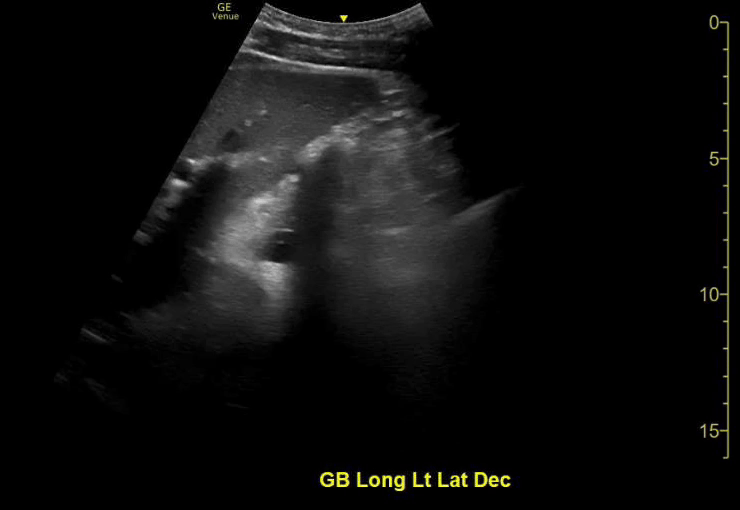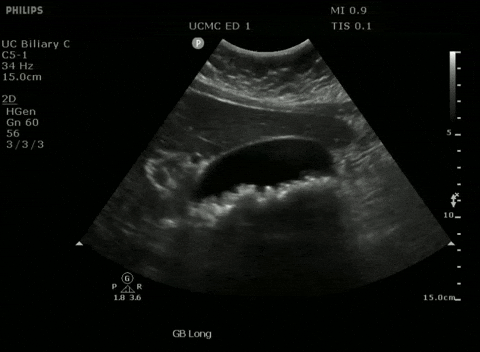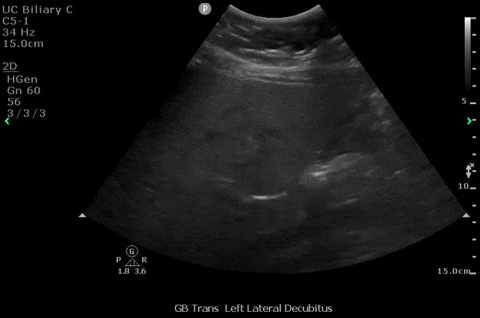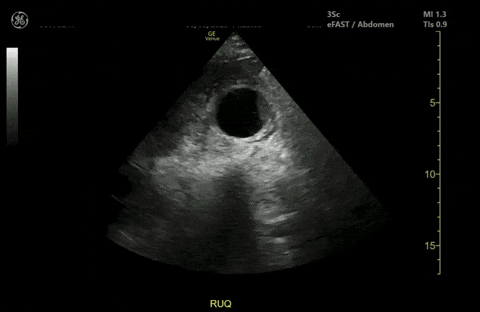INDICATIONS:
Evaluate for cholelithiasis and cholecystitis. Find gallstones, common bile duct dilation, sonographic Murphy’s sign, thickened gallbladder wall, and pericholecystic fluid.
ANATOMY:
Image adapted from Blausen.com staff (2014). "Medical gallery of Blausen Medical 2014". WikiJournal of Medicine 1 (2). DOI:10.15347/wjm/2014.010. ISSN 2002-4436. CC Attribution 3.0, Wiki Commons
In the right upper quadrant of the abdomen, lies the liver and just beneath it, the gallbladder. An elongated pear-shared organ located on the inferior surface of the liver, the gallbladder collects bile for distribution to the duodenum. The body (or fundus) of the gallbladder gradually tapers to its neck which empties into the cystic duct. The cystic duct joins the common hepatic duct to form the common bile duct (CBD). The CBD typically courses with the hepatic artery and the portal vein, which together comprise the portal triad.
Sonographic Anatomy
Sonographically, the gallbladder appears as a cystic anechoic structure with a well-defined wall. However, there are many anatomic variations, physiologic conditions, and nearby structures that can make imaging the gallbladder difficult. Gallbladders may vary in shape, orientation, and location. Gallbladders contract after meals, thus are best visualized after fasting. Furthermore, the gallbladder can become easily obscured by nearby gas-filed structures like the stomach and intestines. If the gallbladder is not examined in its entirety with surrounding anatomy carefully identified, the gallbladder can be easily mistaken as the duodenum, a hepatic or renal cyst, or nearby vasculature and pathology can be missed.
Patient Positioning
Left lateral decubitus scanning position
The exam is best performed with the patient in the supine or left lateral decubitus (LLD) position. Honestly, you’ll be most efficient if you just start with the patient in LLD!! This will help optimize views by shifting structures more medially and out from underneath the rib cage.
Probe Selection
A low frequency transducer is needed to achieve adequate depth. Generally, a curvilinear probe is preferred. However, a phased array probe may be useful if the gallbladder can only be imaged using an intercostal window, but this will diminish the overall image quality in most cases.
Required Images
Gallbladder Long Axis
Full sweep of the gallbladder in long axis
Position your probe in the epigastric midline with the indicator pointing to the patient’s head
Slide the probe laterally and inferiorly along the costal margin in a subcostal sweep, toward the patient’s right flank, until the gallbladder comes into view. If this does not work, sweep along the ribs with a “costal sweep.”
Because the exact position/axis of the gallbladder differs in every patient, you may need to rotate your probe slightly clockwise or counterclockwise to find the axis with the most elongated view of the gallbladder.
With the gallbladder correctly identified, you should see the liver superiorly, the portal triad inferolateral, and stomach/bowel medially.
Rotate your probe so that the gallbladder is seen in its long axis from the neck to the fundus. Fan the probe side to side to visualize the entirety of the gallbladder in this plane.
Gallbladder Short Axis
Full sweep of the gallbladder in short (trans) axis
From the long axis, rotate your probe so that the gallbladder is seen in its short axis. It should look like a small circle.
Fan your probe through the entirety of the gallbladder to look for stones, paying careful attention to the neck of the gallbladder
With the probe exactly perpendicular to the gallbladder, obtain a still image and measure the anterior gallbladder wall thickness while in the transverse plane. We measure the anterior gallbladder wall because the posterior wall will appear artificially thickened due to posterior acoustic enhancement.
Common Bile Duct
Return to your longitudinal view of the gallbladder
Locate the gallbladder neck. This will point to the portal vein. Frequently, you will also see the main lobar fissure – a thin hyperechoic line extending from the neck of the gallbladder to the portal vein. The portal vein appears in its short axis from this view as the dot at the base of the elongated gallbladder, known as the "Exclamation Point" sign.
Just anterior to the portal vein, locate the smaller CBD and hepatic artery which are also seen in short axis. Together, these structures form the “Mickey Mouse” sign with the portal vein seen in the middle representing the face and the CBD and hepatic artery representing the two ears.
Use color Doppler to distinguish the common bile duct from the hepatic artery. Flow will be seen in the hepatic artery, while the common bile duct will remain anechoic with no flow
From the short-axis view of the portal triad, rotate the probe 90 degrees counterclockwise to obtain the CBD in long axis running anteriorly along the portal vein
Once you have identified the CBD in the long axis, measure the diameter from inner wall to inner wall
Still image of the gallbladder in long axis and portal triad in short axis illustrating the "Exclamation Point" sign. The CBD and hepatic artery are seen in trans axis just anterior to the larger portal vein forming the “Mickey Mouse” sign.
CBD shown in long axis running anteriorly along the portal vein
CRITICAL MEASUREMENTS
| Gallbladder Size | Gallbladder Wall | Common Bile Duct |
|---|---|---|
| Long axis < 10 cm = normal | < 3 mm = normal | < 5 mm – normal in patient up to age 50 years old (add 1mm for every decade of life thereafter) |
| Short axis < 4 cm = normal | 3-4 mm = equivocal | 5-7 mm – equivocal |
| > 4 mm = thickened | > 7 mm – dilated |
IMAGE INTERPRETATION
Cholelithiasis
Clip of the gallbladder in long axis with gravity dependent hyperechoic gallstones lying along the inferior wall casting a posterior shadow
Cholelithiasis refers to the presence of gallstones anywhere along the biliary tree. Gallstones are present in up to 10% of the population, and only about 1/4 of these patients are symptomatic. On ultrasound, gallstones appear as hyperechoic structures with a distinct posterior shadow. Stones may be gravity-dependent and move within the gallbladder lumen with changes in patient position. Biliary sludge appears as a similar dependent echoes with shadowing but with mixed echogenicity.
Gallbladder polyps are often mistaken for gallstones. These structures also appear within the gallbladder lumen, but do not exhibit posterior shadowing, gravity dependence, and are generally less hyperechoic compared to stones. Additionally edge artifact – a phenomenon caused the refraction of sound waves along the edge of curved structures – results in a posterior hypoechoic strip that can be easily mistaken for shadowing. This mistake can be mitigated by tracing the shadow back to either a hyperechoic intraluminal structure (stone) or the gallbladder wall (edge artifact). You can also try to visualize the gallbladder from another angle to see if the shadowing persists.
A gallbladder filled with stones produces the “Wall-Echo-Shadow (WES)” sign, which can be challenging to differentiate from bowel. The WES sign consists of two curvilinear hyperechogenic lines separated by a thin hypoechoic space with a dark shadow casted posteriorly. The anterior line represents the gallbladder wall, the hypoechoic line is caused by a thin layer of bile, and the posterior line represents stones within the gallbladder lumen. Nearby bowel can often be mistaken for a WES sign. As discussed above, gallstones cast a sharp, well-defined acoustic shadow oppose to gas-filled bowel, which casts a “dirty shadow” with less defined borders and may demonstrate peristalsis.
Still image of a normal gallbladder in trans axis with green arrows delineating edge artifact
Clip of a gallbladder in short axis demonstrating a WES sign
Cholecystitis
Clip of a gallbladder in short axis demonstrating a thickened edematous gallbladder wall with intraluminal stones consistent with cholecystitis
Cholecystitis, or gallbladder inflammation, occurs when the gallbladder’s drainage ducts are obstructed and the gallbladder becomes inflamed/infected. Cholelithiasis is the most common cause and primary risk factor for developing cholecystitis and is present in up to 95% of cases of cholecystitis. Other sonographic signs suggestive of cholecystitis may include biliary sludge, “positive sonographic Murphy’s sign,” thickened gallbladder wall, pericholecystic fluid, and gallbladder distention.
A sonographic Murphy’s Sign refers to the presence of maximal tenderness when pressure is applied directly over the visualized gallbladder with the ultrasound probe. A thickened gallbladder wall is defined as >4mm. It is important to note that several physiologic states can also cause non-specific gallbladder wall thickening including ascites, congestive heart failure, and a post-prandial state. For this reason, ultrasound findings must be interpreted holistically and in conjunction with clinical reasoning.
Pericholecystic fluid appears as hypoechoic free fluid surrounding the gallbladder, often seen between the gallbladder and liver. In a patient with hepatosteatosis, focal fat sparing adjacent to the gallbladder fossa can mimic pericholecystic fluid.
In rare cases of emphysematous cholecystitis, you may see air within the gallbladder wall or gallbladder lumen. On ultrasound, air will appear as a hyperechogenic foci with “dirty” appearing posterior acoustic shadowing. The “champagne sign” is a pathognomonic sonographic finding of emphysematous cholecystitis and refers to the presence of multiple small hyperechogenic foci of gas that migrate from dependent to non-dependent areas within the gallbladder as the patient changes position. These small echogenic foci mimic rising bubbles of gas in a glass of champagne.
Choledocholithiasis
Still image of a dilated CBD in long axis running anterior to the portal vein illustrating the “Double Barrel” sign
Choledocholithiasis occurs when gallstones become lodged in the common bile duct and bile backs up into the liver. On ultrasound, look out for stones in the gallbladder and/or CBD, and a dilated common bile duct. Identifying the CBD can be surprisingly difficult especially for novice sonographers. If you cannot locate the CBD do not fear. Isolated CBD dilation is exceedingly uncommon (<1%) without associated lab abnormalities or sonographic evidence of gallbladder pathology.
POST BY Jessica Guillaume, MD
Dr. Guillaume is a PGY-2 in Emergency Medicine at the University of Cincinnati
EDITING BY Lori Stolz, MD and Patricia Smith, RDMS
Dr. Stolz is the Emergency Medicine Ultrasound Director and Program Director for the Ultrasound Fellowship at the University of Cincinnati
Pattie Smith is an expert sonographer and ultrasound educator in the Department of Emergency Medicine at the University of Cincinnati
REFERENCES
Abraham, S., Rivero, H. G., Erlikh, I. v, Griffith, L. F., & Kondamudi, V. K. (2014). Surgical and nonsurgical management of gallstones. American Family Physician, 89(10), 795–802.
Becker, B. A., Chin, E., Mervis, E., Anderson, C. L., Oshita, M. H., & Fox, J. C. (2014). Emergency Biliary Sonography: Utility of Common Bile Duct Measurement in the Diagnosis of Cholecystitis and Choledocholithiasis. The Journal of Emergency Medicine, 46(1), 54–60. https://doi.org/10.1016/j.jemermed.2013.03.024
Estrella, A. (2019, May 27). Biliary Ultrasound. CORE EM. https://coreem.net/core/biliary-ultrasound/
Halpin, V. (2014). Acute cholecystitis. BMJ Clinical Evidence, 2014.
Lahham, S., Becker, B. A., Gari, A., Bunch, S., Alvarado, M., Anderson, C. L., Viquez, E., Spann, S. C., & Fox, J. C. (2018). Utility of common bile duct measurement in ED point of care ultrasound: A prospective study. The American Journal of Emergency Medicine, 36(6), 962–966. https://doi.org/10.1016/j.ajem.2017.10.064
MacDonald, F. R., Cooperberg, P. L., & Cohen, M. M. (1981). The WES triad — A specific sonographic sign of gallstones in the contracted gallbladder. Gastrointestinal Radiology, 6(1), 39–41. https://doi.org/10.1007/BF01890219
Rodríguez, Á., Pavón, R., Rionda, P., Flores, P., González, A., Gutiérrez, C., & Martín, D. (2015). “The Effervescent Gallbladder”: A Rare Ultrasonographic Finding that Reflects the Presence of Gas within the Gallbladder. Ultrasound International Open, 01(02), E72–E75. https://doi.org/10.1055/s-0035-1564155
Rybicki, F. J. (2000). The WES Sign. Radiology, 214(3), 881–882. https://doi.org/10.1148/radiology.214.3.r00mr38881
Sonoguide: Gallbladder. (2020, June 10). ACEP. https://www.acep.org/sonoguide/basic/gallbladder
Tooma, D., Dinh, V., Ahn, J., Deschamps, J., Genobaga, S., Lang, A., Lee, V., Krause, R., & White, S. (n.d.). Abdominal Ultrasound Made Easy: Step-By-Step Guide. POCUS101. Retrieved January 19, 2025, from https://www.pocus101.com/abdominal-ultrasound-made-easy-step-by-step-guide/#Gallbladder_Common_Bile_Duct_Ultrasound
















